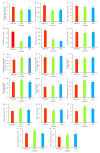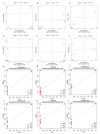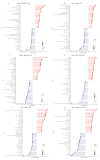Integrated Physiological and Metabolomic Analyses Reveal the Differences in the Fruit Quality of the Blueberry Cultivated in Three Soilless Substrates
- PMID: 36553707
- PMCID: PMC9777891
- DOI: 10.3390/foods11243965
Integrated Physiological and Metabolomic Analyses Reveal the Differences in the Fruit Quality of the Blueberry Cultivated in Three Soilless Substrates
Abstract
With improving living standards, traditional blueberry planting modes cannot meet commercial demands, and blueberry cultivation with soilless substrate has become a popular solution in the blueberry industry. In this study, different soilless substrate treatments were found to markedly influence fruit appearance and intrinsic quality. The fruit in the 50:50 peat/pine bark (v/v) (FPB) treatment group had the maximum single fruit weight, largest vertical diameter, and brightest color, as well as the highest 1,1-diphenyl-2-picrylhydrazyl (DPPH) value, solid-acid ratio and anthocyanin content. The fruit in the 50:50 pine bark/rice husk (v/v) (FBR) treatment group had the highest total phenol and flavonoid levels, largest drip loss value, and lowest total pectin content and firmness value. Metabolomic analysis showed that flavonoid, carbohydrate, and carbohydrate conjugate, and amino acid, peptide, and analog levels were significantly different between groups. Fruit in the FPB group had the highest sucrose, D-fructose 1,6-bisphosphate, salidroside, tectorigenin, naringenin chalcone, trifolirhizin, and galangin contents. The increase in the relative expression of phenylalanine (Phe) promoted the synthesis of fruit polyphenols in the FBR group. Our results provide new insights into the effects of different substrates on the quality of blueberries and a reference for the soilless substrate cultivation of blueberries.
Keywords: blueberry; fruit quality; metabolite; soilless cultivation; substrate.
Conflict of interest statement
The authors declare no conflict of interest.
Figures







Similar articles
-
Full-length fruit transcriptomes of southern highbush (Vaccinium sp.) and rabbiteye (V. virgatum Ait.) blueberry.BMC Genomics. 2022 Oct 29;23(1):733. doi: 10.1186/s12864-022-08935-5. BMC Genomics. 2022. PMID: 36309640 Free PMC article.
-
Rice husk ash based growing media impact on cucumber and melon growth and quality.Sci Rep. 2024 Mar 1;14(1):5147. doi: 10.1038/s41598-024-55622-4. Sci Rep. 2024. PMID: 38429352 Free PMC article.
-
A physiological and metabolomic analysis reveals the effect of shading intensity on blueberry fruit quality.Food Chem X. 2022 Jun 15;15:100367. doi: 10.1016/j.fochx.2022.100367. eCollection 2022 Oct 30. Food Chem X. 2022. PMID: 35769330 Free PMC article.
-
Bioactive Compounds of Blueberries: Post-Harvest Factors Influencing the Nutritional Value of Products.Int J Mol Sci. 2015 Aug 10;16(8):18642-63. doi: 10.3390/ijms160818642. Int J Mol Sci. 2015. PMID: 26266408 Free PMC article. Review.
-
Blueberry fruit valorization and valuable constituents: A review.Int J Food Microbiol. 2022 Nov 16;381:109890. doi: 10.1016/j.ijfoodmicro.2022.109890. Epub 2022 Aug 30. Int J Food Microbiol. 2022. PMID: 36095867 Review.
Cited by
-
Optimizing Alternative Substrate for Tomato Production in Arid Zone: Lesson from Growth, Water Relations, Chlorophyll Fluorescence, and Photosynthesis.Plants (Basel). 2023 Mar 27;12(7):1457. doi: 10.3390/plants12071457. Plants (Basel). 2023. PMID: 37050083 Free PMC article.
-
A Model for Selecting Kiwifruit (Actinidia eriantha) Germplasm Resources with Excellent Fruit Quality.Foods. 2024 Dec 12;13(24):4014. doi: 10.3390/foods13244014. Foods. 2024. PMID: 39766957 Free PMC article.
-
Transcriptomic and Metabolomic Profiling Reveals the Variations in Carbohydrate Metabolism between Two Blueberry Cultivars.Int J Mol Sci. 2023 Dec 25;25(1):293. doi: 10.3390/ijms25010293. Int J Mol Sci. 2023. PMID: 38203463 Free PMC article.
-
Growth, physiological and N, P, K accumulation responses of Erythropalum scandens Bl. Seedlings under different substrates.BMC Plant Biol. 2024 Oct 16;24(1):972. doi: 10.1186/s12870-024-05678-1. BMC Plant Biol. 2024. PMID: 39415146 Free PMC article.
-
Enhancing greenhouse cucumber production and quality utilizing organic residues as potting media through various cultivation modes and assessing application economics.Sci Rep. 2025 Jun 20;15(1):20152. doi: 10.1038/s41598-025-05242-3. Sci Rep. 2025. PMID: 40542076 Free PMC article.
References
-
- Liu B.H., Wang K.F., Shu X.G., Liang J., Fan X.L., Sun L. Changes in fruit firmness, quality traits and cell wall constituents of two highbush blueberries (Vaccinium corymbosum L.) during postharvest cold storage. Sci. Hortic. 2019;246:557–562. doi: 10.1016/j.scienta.2018.11.042. - DOI
-
- Yang L., Liu L.M., Wang Z.Y., Zong Y., Yu L., Li Y.Q., Liao F.L., Chen M.M., Cai K.L., Guo W.D. Comparative anatomical and transcriptomic insights into Vaccinium corymbosum flower bud and fruit throughout development. BMC Plant Biol. 2021;21:289. doi: 10.1186/s12870-021-03067-6. - DOI - PMC - PubMed
-
- Chai Z., Herrera-Balandrano D.D., Yu H., Beta T., Zeng Q.L., Zhang X.X., Tian L.L., Niu L.Y., Huang W.Y. A Comparative Analysis on the Anthocyanin Composition of 74 Blueberry Cultivars from China. J. Food Compos. Anal. 2021;102:104051. doi: 10.1016/j.jfca.2021.104051. - DOI
-
- Sater H., Ferrão L.F., Olmstead J., Munoz P.R., Bai J.H., Hopf A., Plotto A. Exploring environmental and storage factors affecting sensory, physical and chemical attributes of six southern highbush blueberry cultivars. Sci. Hortic. 2021;289:110468. doi: 10.1016/j.scienta.2021.110468. - DOI
Grants and funding
LinkOut - more resources
Full Text Sources

